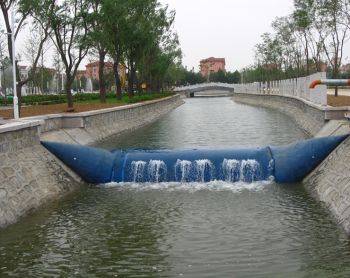Rubber Dams: Difference between revisions
From ASDSO Dam Safety Toolbox
Rmanwaring (talk | contribs) No edit summary |
No edit summary |
||
| Line 16: | Line 16: | ||
Rubber dams are inflatable, cylindrical dams placed across channels that act as a weir or dam to raise the upstream water level when the structure is inflated. They are typically made of a rubberized fabric membrane. Stainless steel mesh or ceramic chips can be embedded in the membrane to hinder vandalism. They can be filled with water, air, or both. Rubber dams are normally used to temporarily increase storage at existing dams, divert water for [[irrigation]], provide flood control, or provide a reservoir for [[recreation]]. | Rubber dams are inflatable, cylindrical dams placed across channels that act as a weir or dam to raise the upstream water level when the structure is inflated. They are typically made of a rubberized fabric membrane. Stainless steel mesh or ceramic chips can be embedded in the membrane to hinder vandalism. They can be filled with water, air, or both. Rubber dams are normally used to temporarily increase storage at existing dams, divert water for [[irrigation]], provide flood control, or provide a reservoir for [[recreation]]. | ||
==Examples== | |||
{{Website Icon}} [https://damfailures.org/case-study/tempe-town-lake-dam-arizona-2010/ Learn more about important design considerations for rubber dams from the Tempe Town Lake Dam case study on DamFailures.org] | |||
{{Website Icon}} [https://damfailures.org/case-study/maple-grove-dam-colorado-1979/ Rubber dams can be prone to vandalism if not protected. Learn more from the failure of Maple Grove Dam at DamFailures.org] | |||
==Best Practices Resources== | |||
{{Document Icon}} [[Engineering Guidelines for the Evaluation of Hydropower Projects: Chapter 10- Other Dams| Engineering Guidelines for the Evaluation of Hydropower Projects: Chapter 10- Other Dams (Federal Energy Regulatory Commission)]] | {{Document Icon}} [[Engineering Guidelines for the Evaluation of Hydropower Projects: Chapter 10- Other Dams| Engineering Guidelines for the Evaluation of Hydropower Projects: Chapter 10- Other Dams (Federal Energy Regulatory Commission)]] | ||
<!-- Revision history information --> | <!-- Revision history information --> | ||
{{revhistinf}} | {{revhistinf}} | ||
Revision as of 23:15, 26 January 2023

|
| An example of an inflatable rubber dam. (Wikipedia) |
Rubber dams are inflatable, cylindrical dams placed across channels that act as a weir or dam to raise the upstream water level when the structure is inflated. They are typically made of a rubberized fabric membrane. Stainless steel mesh or ceramic chips can be embedded in the membrane to hinder vandalism. They can be filled with water, air, or both. Rubber dams are normally used to temporarily increase storage at existing dams, divert water for irrigation, provide flood control, or provide a reservoir for recreation.
Examples
Best Practices Resources
Revision ID: 6482
Revision Date: 01/26/2023
